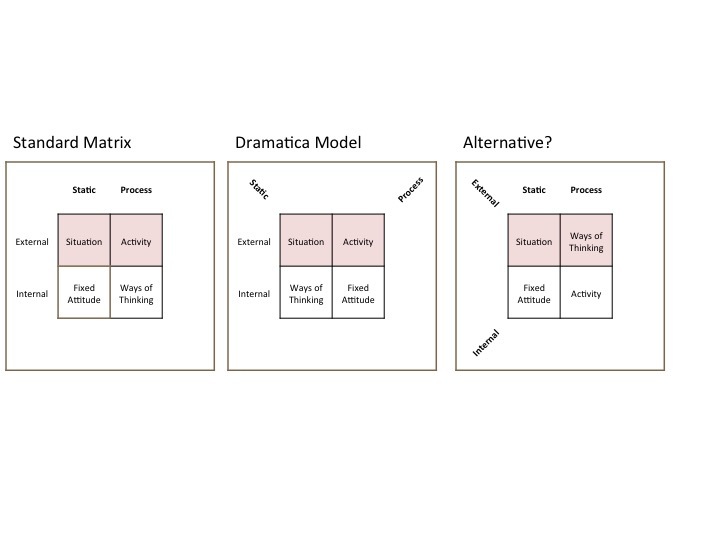When I first came across Dramatica I thought that the domains were structured in a matrix format. I then realised that it wasn’t the case, but the Static vs Active components were actually on the diagonals.
I queried this in the old Convore days and Chris mentioned that he and Melanie chose this structure so when you put the IC and the MC opposite each other diagonally, then when looking at their sources of conflict they would have something in common, and also something they don’t share. In the Dramatica model, they would both have their sources of conflict come from an process/stasis, yet one would experience it from an external source, and one from an internal source.
From what I can deduce, there are 3 structures of the matrix. I would be interested to know why the other alternative model wasn’t included? i.e.(Where the IC and the MC share the locus of conflict, yet experience it from different states.)
I tried to draw it out below.
Disclaimer:
I don’t want what I am about to say come across as if I am dissing the software, or the amazing narrative theory that Dramatic is. I am just arguing a point of view, which probably stems from my naivety. 
Interesting thought Mike. But I wonder if one has been written but we haven’t noticed it as we are measuring it with Dramatica. I would argue that we only measure stories with the tools we have and those tools, (by necessity) have restrictions.
I’ve been listening to some of the Dramatica User Group podcasts, and it seems as though some of the stories, (if not most) the throughlines can be argued to fall either of two or more domains. Eventually it gets settled as one of the other throughlines “force” the decision. e.g. “So we have good arguments that the MC is in Situation, or Activity. When we look at the IC, we all agree that it is in Fixed Attitude, which means our MC MUST be in Situation”. So no matter how strong the argument was that the MC was in Activity, the MC throughline can’t be put in that domain as it is excluded due to the model.
The Dramatica model forces you to adopt a storyform that always has the MC & IC sharing the Stasis/Process. In doing so, you will reject any story point that doesn’t fit into that model.
I would be interested to know how many stories out their have their IC and MC sharing the same locus (external/internal) yet differing on their stasis/process.
That said - I am not going to waste too much time looking for one - or trying to write one. Life’s too short. But it would be interesting to know that a black swan might exist out there somewhere.


